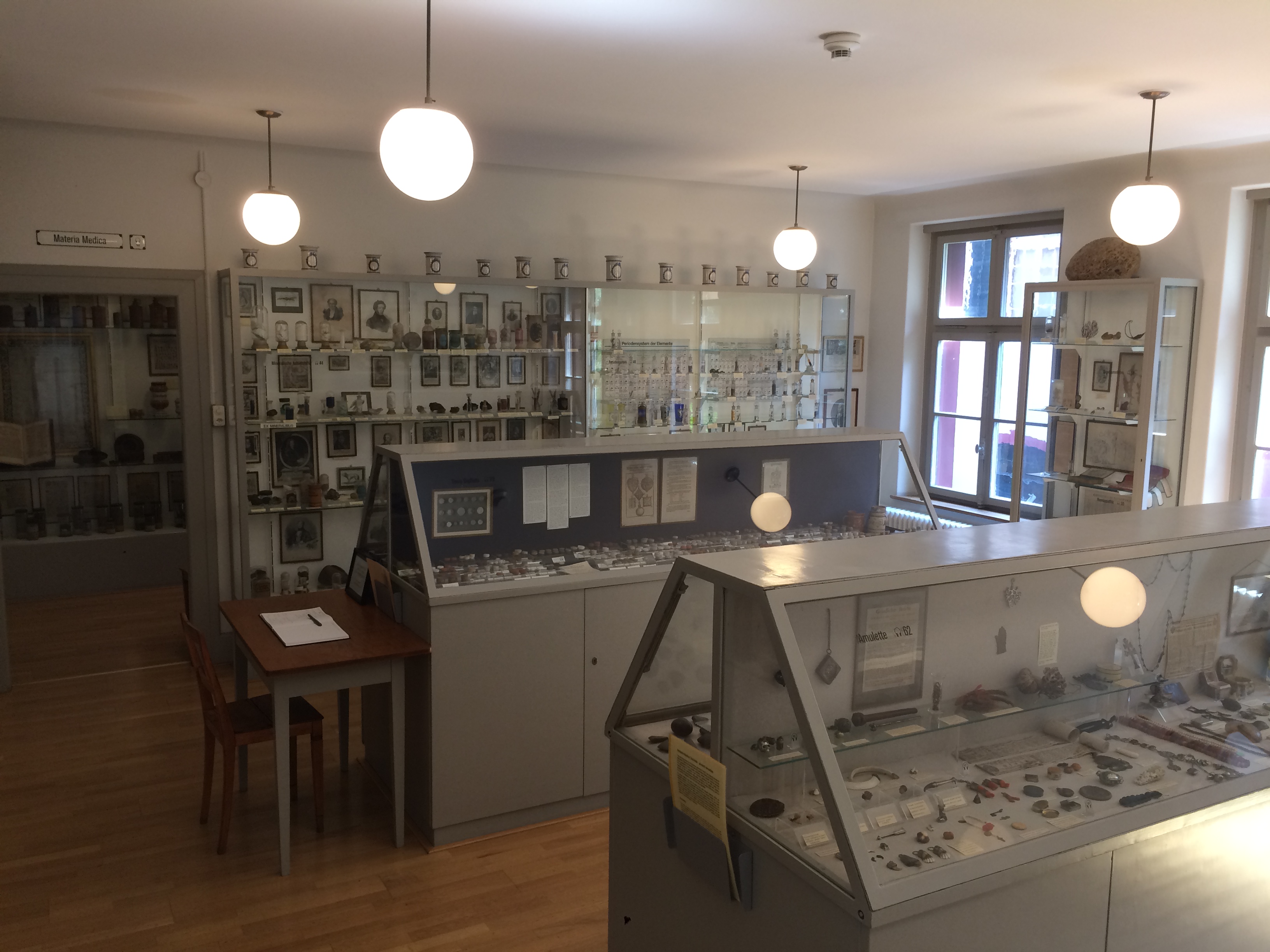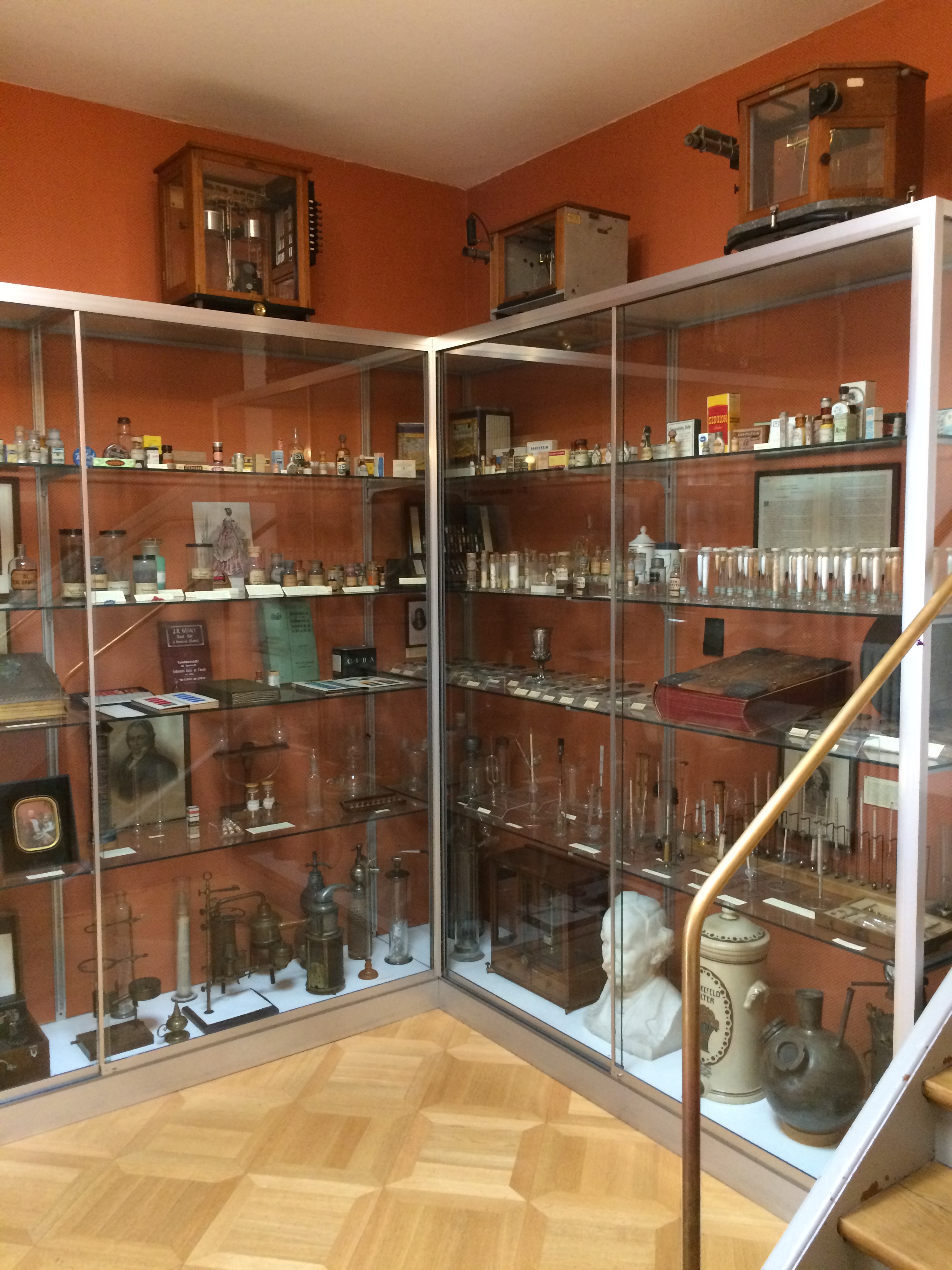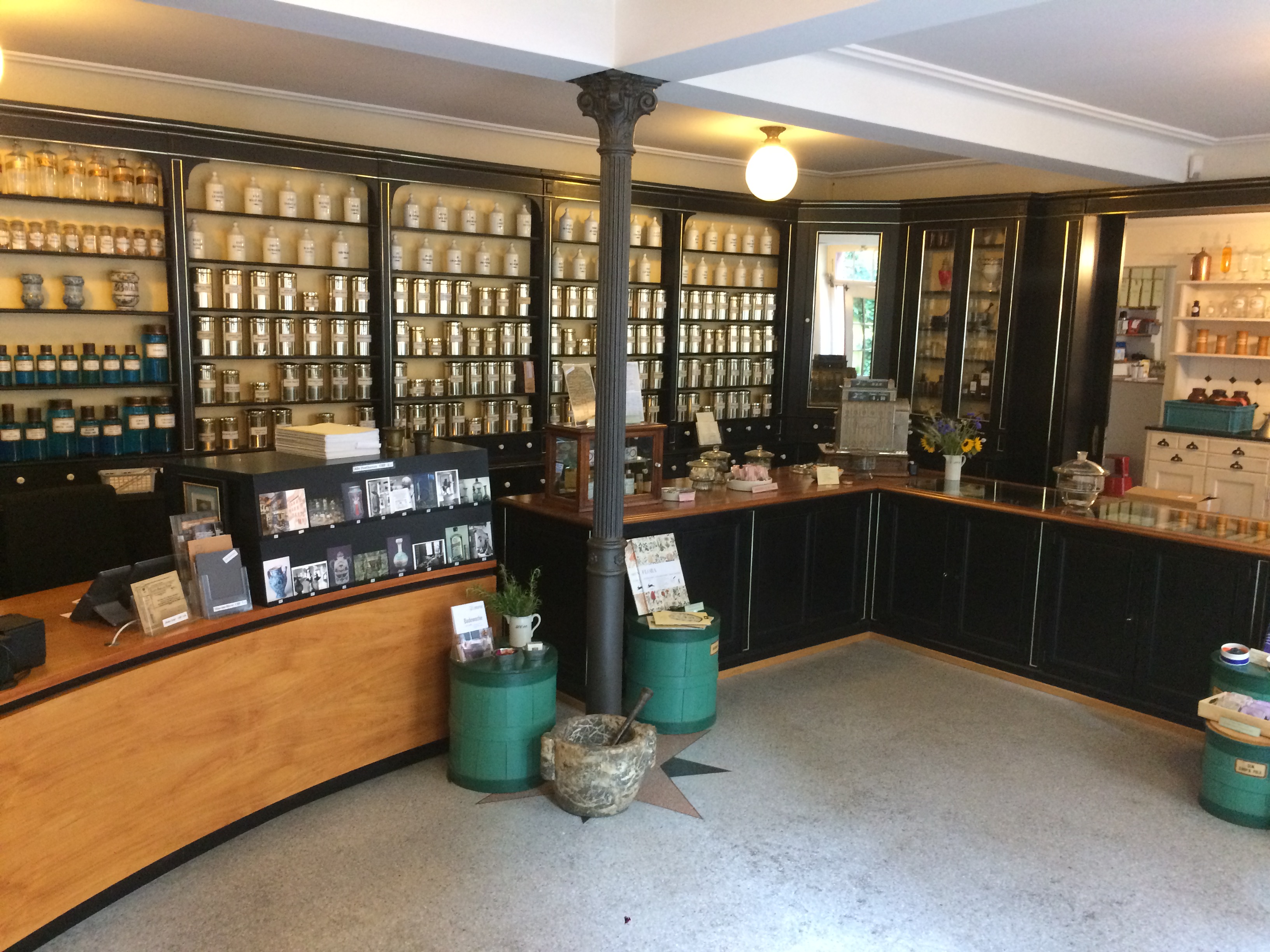Pharmazie-Historisches Museum der UniversitÃĊt Basel on:
[Wikipedia]
[Google]
[Amazon]
 The Pharmacy Museum of the University of Basel (Pharmaziemuseum der UniversitÃĊt Basel, formerly Pharmazie-Historisches Museum der UniversitÃĊt Basel, originally Sammlung fÃỳr das historische Apothekenwesen) shows in its permanent collection the history of medicinal remedies and their preparation. Designed as a collection of specimens for study purposes, the museum was founded in 1924 by Josef Anton HÃĊfliger (1873â1954) and has been preserved to this day in its original form as a 'scientific cabinet'.
The museum is one of the largest and most significant collections of pharmaceutical objects and the history of pharmacy. It contains pharmaceutical ceramics, complete fixtures and fittings from historical pharmacies, an alchemical
The Pharmacy Museum of the University of Basel (Pharmaziemuseum der UniversitÃĊt Basel, formerly Pharmazie-Historisches Museum der UniversitÃĊt Basel, originally Sammlung fÃỳr das historische Apothekenwesen) shows in its permanent collection the history of medicinal remedies and their preparation. Designed as a collection of specimens for study purposes, the museum was founded in 1924 by Josef Anton HÃĊfliger (1873â1954) and has been preserved to this day in its original form as a 'scientific cabinet'.
The museum is one of the largest and most significant collections of pharmaceutical objects and the history of pharmacy. It contains pharmaceutical ceramics, complete fixtures and fittings from historical pharmacies, an alchemical


 Various aspects of diseases and illnesses, as well as various concepts of healing, are exemplified by a considerable collection of drugs and medications from all over the world.
Various aspects of diseases and illnesses, as well as various concepts of healing, are exemplified by a considerable collection of drugs and medications from all over the world.
 The museum shows a prominent collection of pharmaceutical pottery. The so-called
The museum shows a prominent collection of pharmaceutical pottery. The so-called
/ Swissbib Katalog
 Original fittings from the city's 'BarfÃỳsser-Apotheke' are now installed in the museum shop where visitors can choose from a selection of teas, herbs, confectionery, pharmaceutical glassware, soaps and other souvenirs. Entry to the museum shop is free of charge.
Original fittings from the city's 'BarfÃỳsser-Apotheke' are now installed in the museum shop where visitors can choose from a selection of teas, herbs, confectionery, pharmaceutical glassware, soaps and other souvenirs. Entry to the museum shop is free of charge.
Basler Jahrbuch 1956, S. 125â129
* Lutz, Alfons, und Mez-Mangold, Lydia: ''Schweizerisches Pharmazie-Historisches Museum in Basel.'' Bern 1968 and 1974. * Mez-Mangold Lydia: ''Aus der Geschichte des Medikaments.'' Basel 1972. * Olonetzky, Beny, und Mez-Mangold, Lydia: ''Die Sammlung: Darstellung alter Arztinstrumente, Apotheker-GefÃĊsse, Mikroskope, Einnehmelöffel, Terra sigillata, Amulette ïṡẄïṡẄ'' Stuttgart 1980. * Kessler, Michael, und Mez-Mangold, Lydia: ''Womit der Apotheker einst hantierte.'' Basel 1975 and 1990. * Gugger, Beat, und Kessler, Michael: ''Revolution: Apothekerkunst und Industrieprozess.'' Basel 1996. * Kessler, Michael, et al.: ''Strömung, Kraft und Nebenwirkung; Eine Geschichte der Basler Pharmazie.'' Basel 2002. * Kessler, Michael, et al.: ''Leben am TotengÃĊsslein. Das Pharmazie-Historische Museum Basel im Haus "Zum Sessel".'' Basel 2002 and 2015. * Kluge, Martin: ''Mit KrÃĊutersud und Gottvertrauen.'' Basel 2008.
Pharmaziemuseum der UniversitÃĊt Basel - official website
Basel museums website
----
 The Pharmacy Museum of the University of Basel (Pharmaziemuseum der UniversitÃĊt Basel, formerly Pharmazie-Historisches Museum der UniversitÃĊt Basel, originally Sammlung fÃỳr das historische Apothekenwesen) shows in its permanent collection the history of medicinal remedies and their preparation. Designed as a collection of specimens for study purposes, the museum was founded in 1924 by Josef Anton HÃĊfliger (1873â1954) and has been preserved to this day in its original form as a 'scientific cabinet'.
The museum is one of the largest and most significant collections of pharmaceutical objects and the history of pharmacy. It contains pharmaceutical ceramics, complete fixtures and fittings from historical pharmacies, an alchemical
The Pharmacy Museum of the University of Basel (Pharmaziemuseum der UniversitÃĊt Basel, formerly Pharmazie-Historisches Museum der UniversitÃĊt Basel, originally Sammlung fÃỳr das historische Apothekenwesen) shows in its permanent collection the history of medicinal remedies and their preparation. Designed as a collection of specimens for study purposes, the museum was founded in 1924 by Josef Anton HÃĊfliger (1873â1954) and has been preserved to this day in its original form as a 'scientific cabinet'.
The museum is one of the largest and most significant collections of pharmaceutical objects and the history of pharmacy. It contains pharmaceutical ceramics, complete fixtures and fittings from historical pharmacies, an alchemical laboratory
A laboratory (; ; colloquially lab) is a facility that provides controlled conditions in which scientific or technological research, experiments, and measurement may be performed. Laboratory services are provided in a variety of settings: physi ...
, mortars
Mortar may refer to:
* Mortar (weapon), an indirect-fire infantry weapon
* Mortar (masonry), a material used to fill the gaps between blocks and bind them together
* Mortar and pestle, a tool pair used to crush or grind
* Mortar, Bihar, a villag ...
, historical first aid kits, books, medications used in the past, and everything related to the preparation of medicinal remedies.
History
ÂṠZum Vorderen SesselÂḋ, the building that houses the museum, is located in the historic centre ofBasel
, french: link=no, BÃḃlois(e), it, Basilese
, neighboring_municipalities= Allschwil (BL), Hégenheim (FR-68), Binningen (BL), Birsfelden (BL), Bottmingen (BL), Huningue (FR-68), MÃỳnchenstein (BL), Muttenz (BL), Reinach (BL), Riehen (B ...
, half way between the market square
The market square (or sometimes, the market place) is a square meant for trading, in which a market is held. It is an important feature of many towns and cities around the world.St Peter's Church St. Peter's Church, Old St. Peter's Church, or other variations may refer to:
* St. Peter's Basilica in Rome
Australia
* St Peter's, Eastern Hill, Melbourne, Victoria, Australia
* St Peters Church, St Peters, Sydney, New South Wales, Australia
...
. First mentioned in 1316 as the ÂṠUnter KrÃĊmernÂḋ bathhouse, it is rich in history. From 1480, the renowned printer Johannes Amerbach lived there; he was the ancestor of the famous academic Amerbach family. In 1507, the house was acquired by Johannes Frobenius, probably the most famous printer of his day. Erasmus von Rotterdam lived and worked there from 1514 to 1516 as Froben's guest.
The printers were joined by famous illustrators such as Hans Holbein the Younger
Hans Holbein the Younger ( , ; german: Hans Holbein der JÃỳngere; â between 7 October and 29 November 1543) was a German-Swiss painter and printmaker who worked in a Northern Renaissance style, and is considered one of the greatest por ...
and his brother Ambrosius
Ambrosius or Ambrosios (a Latin adjective derived from the Ancient Greek word áỳÎỳÎĠÏÏÏÎṗÎṡÏ, ''ambrosios'' "divine, immortal") may refer to:
Given name:
*Ambrosius Alexandrinus, a Latinization of the name of Ambrose of Alexandria (before 2 ...
, and the engraver Urs Graf
Urs Graf (c. 1485 in Solothurn, Switzerland – possibly before 13 October 1528) was a Swiss Renaissance goldsmith, painter and printmaker (of woodcuts, etchings and engravings), as well as a Swiss mercenary. He only produced two etchings, one ...
. In 1526 and 1527, the famous physician and alchemist Theophrastus von Hohenheim, who styled himself Paracelsus
Paracelsus (; ; 1493 â 24 September 1541), born Theophrastus von Hohenheim (full name Philippus Aureolus Theophrastus Bombastus von Hohenheim), was a Swiss physician, alchemist, lay theologian, and philosopher of the German Renaissance.
He ...
, worked there; he had just moved to Basel and was Froben's family doctor.
ÂṠZum SesselÂḋ House has hosted the Pharmacy Museum of the University of Basel since 1925. The aim of the museum is to explain the scientific, art historical and ethnological aspects of the history of pharmacy.
Founder and Curators
* 1924: Josef Anton HÃĊfliger (Founder) * 1942â1972: Alfons Lutz * 1972â1979: Lydia Mez-Mangold * 1979â1986: Laurentia Leon * 1986â2018: Michael Kessler * Director since January 2020: Philippe Wanner (2018â2020 curator a. i.)Collection
The museum dates back to a time when collections of objects were still essential in scientific teaching and research. It has its origins in the private collection of Josef Anton HÃĊfliger (1873â1954), a pharmacist and lecturer in practical pharmacy and the history of pharmacy. In 1924, he donated his collection of ancient apothecary vessels, obsolete drugs, prescriptions, woodcarvings, paintings and books to theUniversity of Basel
The University of Basel (Latin: ''Universitas Basiliensis'', German: ''UniversitÃĊt Basel'') is a university in Basel, Switzerland. Founded on 4 April 1460, it is Switzerland's oldest university and among the world's oldest surviving universiti ...
. Heinrich Zörnig, director of the 'Pharmazeutische Anstalt' (Department of Pharmacy) founded in 1917, provided several rooms to host the collection. By establishing the collection in the Department of Pharmacy, HÃĊfliger was able to make reference to historical developments as he introduced students to pharmaceutical practices. Objects were used as aids in teaching the history of pharmacy
The history of pharmacy as an independent science dates back to the first third of the 19th century. Before then, pharmacy evolved from antiquity as part of medicine. The history of pharmacy coincides well with the history of medicine, but it's imp ...
and to illustrate the techniques used in the preparation of remedies. The growth of the collection was closely associated with developments in pharmaceutical practice at a time (the first half of the 20th century) when the whole pharmaceutical sector - from research and production to retail sales - was undergoing a profound transformation.
Exhibition
Remedies, drugs and medications

 Various aspects of diseases and illnesses, as well as various concepts of healing, are exemplified by a considerable collection of drugs and medications from all over the world.
Various aspects of diseases and illnesses, as well as various concepts of healing, are exemplified by a considerable collection of drugs and medications from all over the world.
Laboratories
Of the two historical laboratories in the collection, the alchemical laboratory with original exhibits from the 16th and 17th century testifies to the search for the philosopher's stone. The pharmaceutical laboratory dating from the time around 1800 was designed with the manual preparation of medicinal plants in mind.Antique pharmacy interiors
Three antique pharmacy interiors illustrate the history of pharmacy through the ages: The luxuriantly decorated ÂṠHofapothekeÂḋ (Court Pharmacy) fromInnsbruck
Innsbruck (; bar, Innschbruck, label=Austro-Bavarian ) is the capital of Tyrol and the fifth-largest city in Austria. On the River Inn, at its junction with the Wipp Valley, which provides access to the Brenner Pass to the south, it had a p ...
dates back to 1755. The pharmacy of the years around 1820 is designed in the classical style of the Empire. The transition to the industrial era is seen in the fixtures and fittings from the former Basel
, french: link=no, BÃḃlois(e), it, Basilese
, neighboring_municipalities= Allschwil (BL), Hégenheim (FR-68), Binningen (BL), Birsfelden (BL), Bottmingen (BL), Huningue (FR-68), MÃỳnchenstein (BL), Muttenz (BL), Reinach (BL), Riehen (B ...
ÂṠBarfÃỳsser-ApothekeÂḋ (BarfÃỳsser Pharmacy), designed shortly before 1900. Today its interior functions as the museum shop and is located in the entrance to the museum.
Faience
 The museum shows a prominent collection of pharmaceutical pottery. The so-called
The museum shows a prominent collection of pharmaceutical pottery. The so-called Faience
Faience or faßence (; ) is the general English language term for fine tin-glazed pottery. The invention of a white pottery glaze suitable for painted decoration, by the addition of an oxide of tin to the slip of a lead glaze, was a major ...
have been used as containers for basic materials and remedies in pharmacies since the 15th century.
Research
The Pharmacy Museum, as one of the two University Museums of Basel, is actively engaged in scientific research and teaching. There are courses inhistory of pharmacy
The history of pharmacy as an independent science dates back to the first third of the 19th century. Before then, pharmacy evolved from antiquity as part of medicine. The history of pharmacy coincides well with the history of medicine, but it's imp ...
, history of natural sciences and life sciences
This list of life sciences comprises the branches of science that involve the scientific study of life â such as microorganisms, plants, and animals including human beings. This science is one of the two major branches of natural science, th ...
on a regular basis. Furthermore, the Pharmacy Museum promotes the scientific exploration of the history of pharmacy
The history of pharmacy as an independent science dates back to the first third of the 19th century. Before then, pharmacy evolved from antiquity as part of medicine. The history of pharmacy coincides well with the history of medicine, but it's imp ...
as well as research based on objects and collection.
Library
The Pharmacy Museum is the home of a scientific library, containing literature and information aboutpharmacy
Pharmacy is the science and practice of discovering, producing, preparing, dispensing, reviewing and monitoring medications, aiming to ensure the safe, effective, and affordable use of medication, medicines. It is a miscellaneous science as it ...
, about its related sciences and about its history. Moreover, it contains material whose collection had not been originally intended, such as drug compendiums, advertising brochures, price and tariff lists and so forth). Books and goods from the library can not be lent out, they have to be viewed and used on location. The use of the library is free of charge. The inventory is retrievable over the Swissbib catalogue/ Swissbib Katalog
Museum Shop â Shopping like one hundred years ago
 Original fittings from the city's 'BarfÃỳsser-Apotheke' are now installed in the museum shop where visitors can choose from a selection of teas, herbs, confectionery, pharmaceutical glassware, soaps and other souvenirs. Entry to the museum shop is free of charge.
Original fittings from the city's 'BarfÃỳsser-Apotheke' are now installed in the museum shop where visitors can choose from a selection of teas, herbs, confectionery, pharmaceutical glassware, soaps and other souvenirs. Entry to the museum shop is free of charge.
Opening hours, Tickets and guided tours
The museum is open from Tuesday to Sunday, 10am - 5pm. The museum is closed on Mondays and public holidays. The ticket for the museum is also valid in the Museum of Anatomy of the University of Basel on the same or the following day. Staff and students of theUniversity of Basel
The University of Basel (Latin: ''Universitas Basiliensis'', German: ''UniversitÃĊt Basel'') is a university in Basel, Switzerland. Founded on 4 April 1460, it is Switzerland's oldest university and among the world's oldest surviving universiti ...
have free admission to both museums.
There is a public guided tour of the museum on the first Sunday of every month at 2pm.
See also
* Museums in BaselLiterature (in German)
* HÃĊfliger, Josef Anton: ''Pharmazeutische Altertumskunde und die Schweizerische Sammlung fÃỳr historisches Apothekenwesen an der UniversitÃĊt Basel.'' Zurich 1931. * HÃĊfliger, Josef Anton: ''Das Apothekenwesen Basels.'' Basel 1938. * Lutz, Alfons: ''Josef Anton HÃĊfliger, der BegrÃỳnder der pharmazeutischen Altertumskunde (1873-1954)''. InBasler Jahrbuch 1956, S. 125â129
* Lutz, Alfons, und Mez-Mangold, Lydia: ''Schweizerisches Pharmazie-Historisches Museum in Basel.'' Bern 1968 and 1974. * Mez-Mangold Lydia: ''Aus der Geschichte des Medikaments.'' Basel 1972. * Olonetzky, Beny, und Mez-Mangold, Lydia: ''Die Sammlung: Darstellung alter Arztinstrumente, Apotheker-GefÃĊsse, Mikroskope, Einnehmelöffel, Terra sigillata, Amulette ïṡẄïṡẄ'' Stuttgart 1980. * Kessler, Michael, und Mez-Mangold, Lydia: ''Womit der Apotheker einst hantierte.'' Basel 1975 and 1990. * Gugger, Beat, und Kessler, Michael: ''Revolution: Apothekerkunst und Industrieprozess.'' Basel 1996. * Kessler, Michael, et al.: ''Strömung, Kraft und Nebenwirkung; Eine Geschichte der Basler Pharmazie.'' Basel 2002. * Kessler, Michael, et al.: ''Leben am TotengÃĊsslein. Das Pharmazie-Historische Museum Basel im Haus "Zum Sessel".'' Basel 2002 and 2015. * Kluge, Martin: ''Mit KrÃĊutersud und Gottvertrauen.'' Basel 2008.
In-house publications (in German)
* Kluge, Martin: ''Drachen in der Medizin. Reale Arznei aus irrealen Wesen.'' Exhibition catalogue; Basel 2005. * HÃĊner, Flavio, und Kessler, Michael: ''Lust, Leid und Wissen. Eine Geschichte der Syphilis und ihrer Therapie.'' Exhibition catalogue; Basel 2008 * Kluge, Martin: ''Mit KrÃĊutersud und Gottvertrauen.'' Basel 2008. * Mischke, JÃỳrgen: '' Mumienharz und SchÃĊdelmoos. Der Mensch als Arzneimittel.'' Basel 2010. * Valerius-Mahler, Christiane: ''Kickstart. Koffein im Blut.'' Exhibition catalogue; Basel 2012. * Valerius-Mahler, Christiane: ''Strahlung. Die zwei Gesichter der RadioaktivitÃĊt.'' Exhibition catalogue; Basel 2014. * Kessler, Michael, et al.: ''Leben am TotengÃĊsslein. Das Pharmazie-Historische Museum Basel im Haus "Zum Sessel".'' Basel 2002 and 2015. * Kessler, Michael: ''Zur Frage nach psychotropen Stoffen im Rauch von brennendem Gummiharz der Boswellia sacra.'' Inaugural dissertation, Basel 1989; new edition 2019.External links
Pharmaziemuseum der UniversitÃĊt Basel - official website
Basel museums website
----